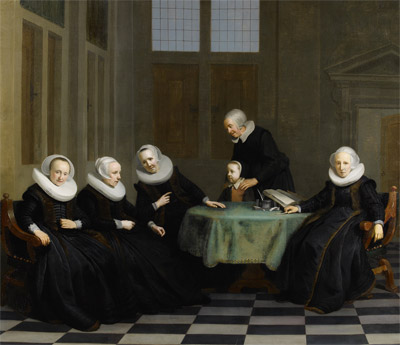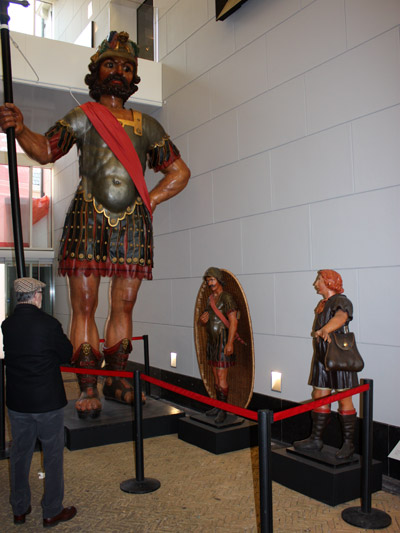Amsterdam used to be a small fishing village on the river Amstel. See, read about, hear and experience how Amsterdam has developed into the metropolis of today.
former Amsterdams Historisch Museum
Amsterdam used to be a small fishing village on the river Amstel. See, read about, hear and experience how Amsterdam has developed into the metropolis of today.

Bird's-Eye View of Amsterdam, 1538
It was commissioned by the governors of the city and hung in the Town Hall for many years.
In this painting, south points up and north points down. Amsterdam is shown as a walled city, situated in a waterlogged area at the mouth of the River Amstel.
Churches, convents and city gates are the most striking buildings in the city which, in 1538, had a population of about 12,000.
Cargo vessels dropped anchor outside the palisade in the IJ. The goods were then loaded onto lighters, which transported them along Damrak to the centre of the city. On Dam Square the goods were weighed and traded.
Many boats were needed for Amsterdam's carrying trade. On the left, outside the canal circling the city, are shipyards, roperies and sawmills.
Amsterdam Museum
Kalverstraat 92
Amsterdam (Centrum)
tram 1 2 4 5 9 14 16 24 25 Spui
directions_subway 52 Rokin
local_parking Q-Park Kalverstraat
| Opening hours | |||
|---|---|---|---|
| Sun | 10:00 | - | 17:00 |
| Mon | 10:00 | - | 17:00 |
| Tue | 10:00 | - | 17:00 |
| Wed | 10:00 | - | 17:00 |
| Thu | 10:00 | - | 17:00 |
| Fri | 10:00 | - | 17:00 |
| Sat | 10:00 | - | 17:00 |
| Entrance fee | |
|---|---|
| €18 | adults |
| €7.50 | students |
| free | 0-17 years |
official website
www.amsterdammuseum.nl
• Tip • Every year in the first week of October the museum is open free of charge.
The Amsterdam Museum tells the compelling story of the growth and heyday of this unique city.
There's a grand tour for those with plenty of time or, if you're in a hurry, follow the tour of the highlights of the museum.
The museum has on display paintings, models, archeological findings, photographs, but also less likely items such as a playable carillon, a Witkar (environment-friendly vehicle from the 1960s) and a replica of Café 't Mandje (a famous pub in the Red Light District where prostitutes, pimps, seamen and lesbian women came together).
The Amsterdam Museum (AM) has posted photos and descriptions of some 90,000 of its objects online.
The Amsterdam Museum reflects the tolerance, enterprising spirit and individuality of a city that for centuries has attracted people from the corners of the earth.
The Antwerp merchants and the Sephardic Jews in the 17th century, the farmers from Friesland in the north of the country and Brabant in the south in the 19th century, and the workers from the Mediterranean countries in the 20th century -- they've all contributed to the story of a unique international city. In the Amsterdam Museum you'll share their experiences.
The Civic Guard Gallery (Schuttersgalerij), a covered street leading from Begijnensteeg to the museum, is one of the few freely accessible 'museum streets' in the world.
Original group portraits, made between 1530 and 2007 by artists such as Bartholomeus van der Helst and Erwin Olaf, hang in the gallery.
Even Goliath can be found here: our world famous 370-year-old wooden giant.

The Amsterdam Museum is a complex of 25 interconnected buildings around two inner courtyards.
These very nice buildings belonged to a former monastery and the former Civic Orphanage (Burgerweeshuis). The orphanage was home to thousands of children between 1580 and 1960, many of whom had lost their parents to the plague.
The museum is located in the heart of the old city.
It can be reached via Amsterdam's main shopping street Kalverstraat or from Spui square via a narrow street.
more impressions


Park directions_car + Bike directions_bike
to the museumPark at nearest hub, switch to bike



history & culture
A Short History of Amsterdam